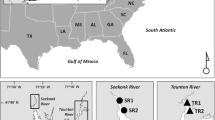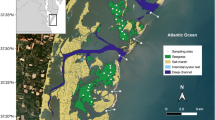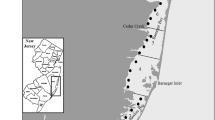Abstract
A study was conducted to define winter distribution patterns of blue crabs,Callinectes sapidus, in the lower Chesapeake Bay and to relate these patterns to environmental variation. During February 1986 a stratified random survey was conducted to examine the distribution of blue crabs with respect to three major habitat types: 1) high energy, wave- and tide-dominated, spits and shoals; 2) moderate energy, tide-dominated basins; and 3) variable energy, tide-dominated or quiescent channels (natural or cut). Each major habitat type was further stratified on the basis of location (to account for possible salinity effects), resulting in a total of 17 habitat-stratum combinations. Blue crabs exhibited significant differences in abundance among habitats. Crabs were most abundant in the basin habitat and least abundant in the shoal and spit habitat. A posteriori evaluations of abundance patterns in relation to sediment type and depth showed that crabs were significantly more abundant where sediments contained between 41 and 60% sand and at depths exceeding 9 m. The sampled population of blue crabs was dominated by mature females. There were no significant differences in crab sex ratios between habitats, but significant differences between two fixed sites sampled through the winter showed that there were proportionately more male crabs at the western site than there were at the eastern site. The observed patterns indicate that some differential habitat utilization occurs and that overwintering female crabs are found preferentially in areas characterized by moderate energy regimes and fine, but sandy sediments.
Similar content being viewed by others
Literature Cited
Boon, J. D., W. F. Bohlen, andL. D. Wright. 1987. Estuarine versus inner shelf disposal sites: A comparison of benthic current regimes, p. 571–583.In Coastal Sediments 87, WW Div/ASCE, New Orleans, Louisiana, May 12–14, 1987.
Byrne, R. J., C. H. Hobbs III, and M. J. Carron. 1982. Sediment studies to determine distribution and sedimentation patterns, and budget in the Chesapeake Bay. Final Rept. to the Environmental Protection Agency (NTIS TB83-224899). 150 p.
Cargo, D. G. 1958. The migration of adult female blue crabs,Callinectes sapidus Rathbun, in Chincoteague Bay and adjacent waters.J. Mar. Res. 16:180–191.
Churchill, E. P., Jr. 1921. Life history of the blue crab.Bull. US Bur. Fish. 36:95–128.
Cronin, L. E. 1949. Comparison of methods of tagging the blue crab.Ecology 30:390–394.
Darnell, R. M. 1959. Studies of the life history of the blue crab (Callinectes sapidus Rathbun) in Louisiana waters.Trans. Am. Fish. Soc. 88:294–304.
Eldridge, P. J., and W. Waltz. 1977. Observations on the commercial fishery for blue crabs,Callinectes sapidus, in estuaries in the southern half of South Carolina. South Carolina Mar. Resour. Cent., Tech. Rept. 21, 35 p.
Fiedler, R. H. 1930. Solving the question of crab migrations.Fish. Gazette 47:18–21.
Fleiss, J. L. 1981. Statistical Methods for Rates and Proportions. John Wiley and Sons, New York. 321 p.
Hay, W. P. 1905. The life history of the blue crab (Callinectes sapidus).Rept. US Bur. Fish 1904:395–413.
Heck, K. L., andR. J. Orth. 1980. Structural components of eelgrass (Zostera marina) meadows in the lower Chesapeake Bay—Decapod Crustacea.Estuaries 3:289–295.
Hines, A. H., R. N. Lipcius, andA. M. Haddon. 1987. Population dynamics and habitat partitioning by size, sex and molt stage of blue crabs,Callinectes sapidus, in a subestuary of central Chesapeake Bay.Mar. Ecol. Prog. Ser. 36:55–64.
Jaworski, E. 1972. The blue crab fishery, Barataria estuary, Louisiana. La. State Univ., Sea Grant Publ. LSU-SC-72-01. 112 p.
Judy, M. H., andD. L. Dudley. 1970. Movements of tagged crabs in North Carolina waters.Commer. Fish. Rev. 32:29–35.
Millikin, M. R., and A. B. Williams. 1984. Synopsis of biological data on the blue crab,Callinectes sapidus Rathbun. NOAA Tech. Rept. NMFS 1, 39 p.
Norse, E. A. 1975. The ecology of blue crabs, genusCallinectes (Brachyura: Portunidae), in the Caribbean. Ph.D. Dissertation, Univ. Southern California, Los Angeles, California. 260 p.
Oesterling, M. J. 1976. Reproduction, growth and migration of blue crabs along Florida’s gulf coast. Univ. Florida, Florida Sea Grant Publ. SUSF-SG-76-003, 19 p.
Perry, H. M. 1975. The blue crab fishery in Mississippi.Gulf. Res. Rep. 5:39–57.
Porter, H. J. 1956. Delaware blue crab.Estuarine Bull. 2:3–5.
Schaffner, L. C., R. J. Diaz, andR. J. Byrne. 1987. Processes affecting recent estuarine stratigraphy, p. 584–599.In Coastal Sediments 87, WW Div/ASCE, New Orleans, Louisiana, May 12–14, 1987.
SPSS Inc. 1983. SPSS User’s Guide. McGraw Hill, New York. 806 p.
Stroup, E. D., and R. J. Lynn. 1963. Atlas of salinity and temperature distributions in Chesapeake Bay. Chesapeake Bay Inst. Rept. 2, 410 p.
Tagatz, M. E. 1968. Biology of the blue crab,Callinectes sapidus Rathbun, in the St. Johns River, Florida.US Fish Wildl. Ser. Fish. Bull. 67:281–288.
Van Den Avyle, M. J., and D. L. Fowler. 1984. Species profiles: Life histories and environmental requirements of coastal fishes and invertebrates (South Atlantic)—Blue crab. US Fish Wildl. Serv. FWS/OBS-82/11.19. US Army Corps of Engineers, TR EL-82-4, 16 p.
Van Engel, W. A. 1962. The blue crab and its fishery in Chesapeake Bay. Part 2—Types of gear for hard crab fishing.Commer. Fish. Rev 24:1–10.
Wright, L. D., D. B. Prior, C. H. Hobbs, R. J. Byrne, J. D. Boon, L. C. Schaffner, andM. O. Green. 1987. Spatial variability of bed roughness in the lower Chesapeake Bay and adjoining estuaries and inner shelf.Estuarine Coastal Shelf Sci. 24:765–784.
Author information
Authors and Affiliations
Rights and permissions
About this article
Cite this article
Schaffner, L.C., Diaz, R.J. Distribution and abundance of overwintering blue crabs,Callinectes sapidus, in the lower Chesapeake Bay. Estuaries 11, 68–72 (1988). https://doi.org/10.2307/1351719
Received:
Accepted:
Issue Date:
DOI: https://doi.org/10.2307/1351719




